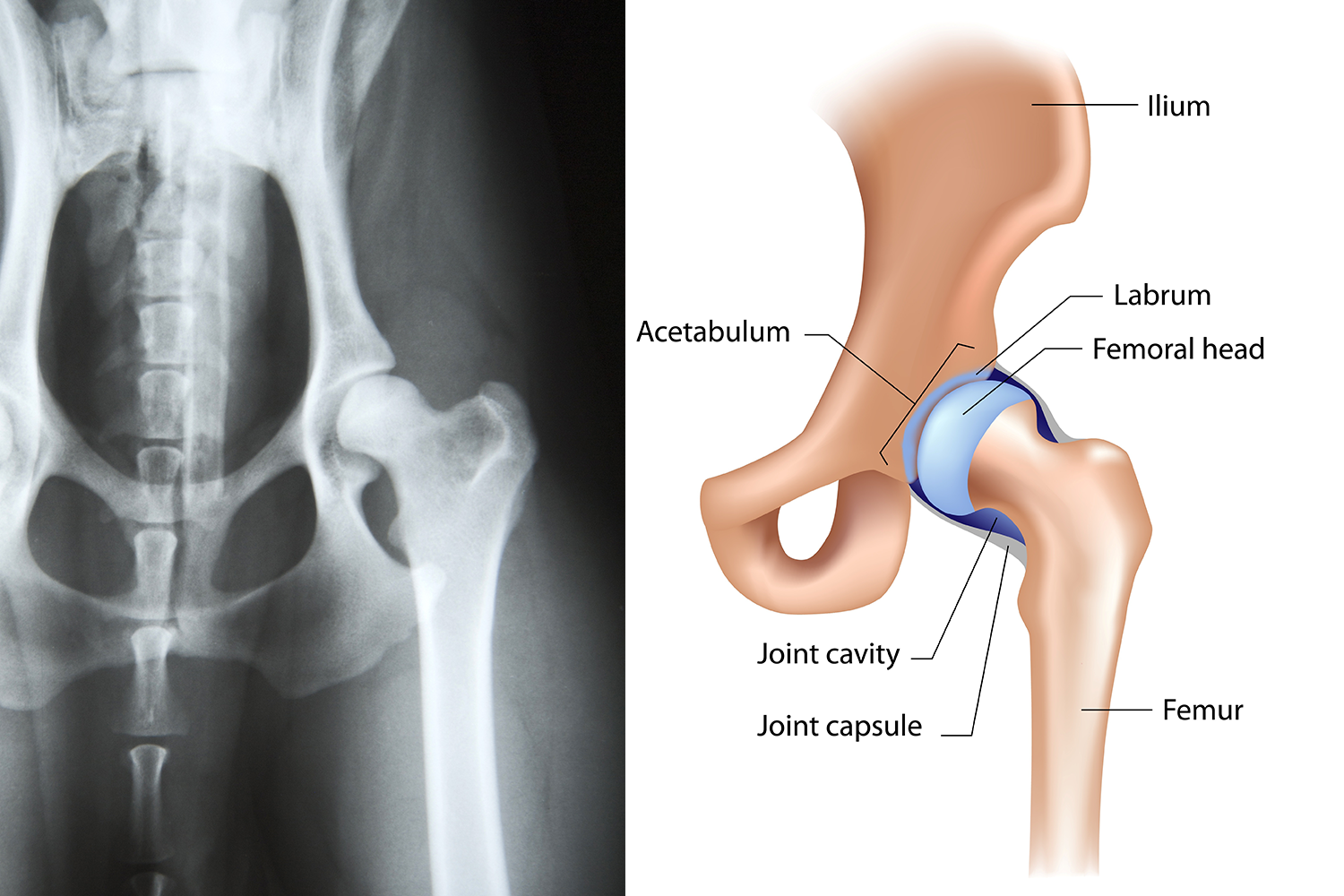Hip dysplasia is a common problem in large breed dogs, in fact the bigger the dog the greater the risk. But small and medium sized dogs are not immune. If you have a dog or you're thinking about getting one, it's worth knowing about hip dysplasia.
Here we'll take a look at what hip dysplasia is, why it occurs and how we can manage it.
What is hip dysplasia?
The term dysplasia means abnormal growth or development of an organ or tissue. So hip dysplasia is abnormal development of the hip. It occurs during a puppy's growth phase.
To understand the abnormal, we first need an idea of what's normal.
The normal hip
The hip is the ball and socket joint between the pelvis and the thigh bone. The ball of the hip joint is actually the head of the femur (thigh bone). The socket (acetabulum) is part of the pelvis. The ball fits snuggly in the socket and is held in place by soft tissues (ligaments, the fibrous joint capsule and muscles). The bone surfaces are covered in thick cartilage and lubricating fluid allowing for smooth, gliding movement in multiple directions.
Left: X-ray of a relatively normal dog hip. Right: diagram of a human hip – the joint is essentially the same, but the shape of the pelvis is different.
THe dysplastic hip
With hip dysplasia, the ball doesn't fit well in the socket, which means there is some separation between the bones. Instead of a nice smooth gliding motion, dysplastic hips tend to clunk and grind. This can lead to inflammation, muscle strain, wearing away of the cartilage, bony scarring and even tiny fractures around the edge of the socket.
Over time, the wear and tear can result in osteoarthritis.
X-ray of dysplastic hips – before the development of arthritis
What causes hip dysplasia?
Hip dysplasia is a nature and nurture disorder – it's due to a combination of genetic and other factors.
In science speak, hip dysplasia is what's known as a polygenic multifactorial disease. This means there is more than one gene involved and it is caused by a number of other factors as well.
Genetics
The genes for hip dysplasia are passed down from parent to offspring. But it's not a simple inheritance. It can skip generations – meaning your puppy can develop hip dysplasia even if his parents had good hips but they were carrying hip dysplasia genes.
Since genetics are involved, we see hip dysplasia more commonly in certain breeds. Traditionally, these have been large breeds: Alaskan Malamute, German Shepherd, Golden Retriever, Labrador Retriever, Newfoundland, Old English Sheepdog, Rottweiler, Saint Bernard and Samoyed.
Note that I said 'traditionally' – things are changing. In an extensive study by the Orthopaedic Foundation for Animals, among dogs born between 2011–2015, the top two breeds for hip dysplasia were Bulldogs and Pugs.
To clarify – only dogs that have hip dysplasia genes can develop hip dysplasia. But carrying the gene doesn't definitely mean hip dysplasia will occur. This depends on the other factors.
Other factors
The other factors that we know about (there are probably lots that we don't) are nutrition, exercise and hormones. While you can't change your dog's genetic code, you can help reduce the severity of hip dysplasia by being aware of these other factors.
Nutrition
Eating too much high calorie, high carbohydrate food during the main bone growth period (ie 3–10 months of age) is linked to puppies (with hip dysplasia genes) developing the disease.
Feed your pup a balanced (species and size/breed appropriate) diet.
Lots of people ask us things like, 'I'm feeding half a cup of food twice a day, is that right?' The answer is always, 'That depends on the food.'
Check the packet for a feeding guide - if the food doesn't have one, look for a better quality food.
If you want to feed a home diet, you need to do your research. It's really important to get the right balance of things like calcium and phosphorus. Take a look at the Balance It website for recipes.
Exercise
Exactly what the best exercise is for preventing hip dysplasia is not yet known.
We do know that not allowing your pup to exercise is not the right thing to do – we want to develop and maintain good muscle mass. Good muscles help develop and support good joints.
Puppies allowed to run around off-leash have been shown to have a reduced risk of hip dysplasia. But you might want to limit activities like ball chasing as jumping or sudden stopping/pivoting can stress joints. Avoid your pup exercising on slippery surfaces
You might also want to avoid stairs early on. One study found than pups allowed to run freely up and down stairs before 3 months of age had a higher risk of hip dysplasia.
Hormones
Here we're really talking about neutering age.
Early neutering (before 6 months of age) has been linked to hip dysplasia in larger breeds that carry the genes.
In male dogs, testosterone helps muscles develop and it also stops bone growth – early castration can therefore mean dogs grow taller but have less muscle bulk to support their frame. There appears to be something similar with female dogs.
We do recommend neutering, but the best timing should be worked out for each individual.
Now if you've got a pup from a rescue centre (or from some breeders), he or she may have been neutered at a very young age – there's nothing that you can do about this, but you can focus on nutrition and exercise.
How do I know if my dog has hip dysplasia?
The diagnosis of hip dysplasia is usually made either because the dog is showing symptoms or as a result of hip scoring.
What are the symptoms of hip dysplasia?
A dog with hip dysplasia may show one or more of these signs:
an abnormal gait (swivel or hip wiggle)
difficulty rising or lying down
bunny-hopping when running or going up stairs
poor thigh muscle mass
low exercise tolerance
reluctant to climb stairs or get up into car/onto furniture
an audible click when walking
Don't expect a dog with hip dysplasia (or any other chronically painful condition) to yelp or cry in pain.
If your dog has any of these symptoms, one of the first things we'll do during an examination is extend the hind legs backward to assess for pain on hip extension. Depending on patient compliance and size, we might also do what's called an Ortolani manoeuvre – this involves having your dog lie on his back with his thighs being moved outward looking for a clunk. As you might imagine, this is often only possible to do under sedation.
To confirm the diagnosis, we really need to perform X-rays. The position your dog needs to be in to assess the hips is lying on his back with both back legs rotated around and pulled back straight. This position is painful for dogs with hip dysplasia, so sedation or general anaesthetic is needed. X-rays not only diagnose hip dysplasia, they can also show secondary arthritic change.
It's important to note that the severity of signs doesn't always match what we see on X-rays. Dogs with minor symptoms can have horrendous looking X-rays and dogs with minor changes on X-ray can be really painful.
Hip scoring
This is other way we diagnose hip dysplasia is during hip scoring. This is usually only done in dogs intended for breeding purposes.
Hip scoring involves taking X-rays (in the same position as above) and then sending those to a registered body for assessment. There are currently two bodies doing hip scoring:
Canine Hip and Elbow Dysplasia Scheme (CHEDS) – Australian
PennHIP® – American (available online)
How is hip dysplasia treated?
We can treat hip dysplasia conservatively with pain medications, physiotherapy and acupuncture. There are also supplements that can help with cartilage preservation/repair and reduce inflammation. Unfortunately, there are no medical treatments will reverse or prevent hip dysplasia.
For some dogs, surgery is the best option. There are lots of different surgical techniques – some are controversial, some are not, some can be done by us, some require a specialist. Most involve significant expense and a recovery period.
Here are some of most commonly used surgical options:
Femoral head ostectomy
Femoral head ostectomy (FHO) is the surgical removal of the ball part of the ball and socket joint. By removing the ball, we stop the painful bone on bone contact. The hip still functions well because as the joint capsule heals, it creates a false joint.
This procedure is best for active smaller dogs. Most dogs tend not to want to use leg for the first 2 weeks (although activity can begin immediately after surgery). By 4–6 weeks, dogs will usually be partially using the leg and by 8–12 weeks activity should be near normal.
This procedure is less expensive than some of the others and can be done at Elwood Vet.
Total hip replacement
This is where the damaged hip joint is removed and replaced by a prosthetic hip. This is therefore most appropriate for dogs where secondary arthritic change has occurred. You might be familiar with this procedure as it's commonly done in people with hip osteoarthritis or fractures.
A total hip replacement is a specialist procedure. It is expensive and involves about 3 months of rehabilitation, but it has about a 90% success rate. Usually, only one hip is done at a time and sometimes the dog does well enough with just one done that further surgery isn't needed.
Double or Triple pelvic osteotomy
A double or triple pelvic osteotomy (DPO or TPO) is most appropriate for younger dogs (8–18 months) with hip dysplasia but without degenerative arthritic changes. It involves cutting the pelvis into pieces, allowing the acetabulum (socket) to be repositioned over the femoral head (ball) to create a tighter fit. Once in the desired position, the pelvis is plated back together.
It is possible to perform a DPO/TPO on both hips at the same time, although often doing just one side provides enough benefit that surgery on the other side isn't needed.
A TPO is a specialist procedure. It is expensive and at least 3 months of exercise restriction post-op is needed.
Other surgical procedures are: juvenile pubic symphysiodesis (done on puppies before 5 months of age) and hip denervation (done where there is pain but the hip is still quite stable).









